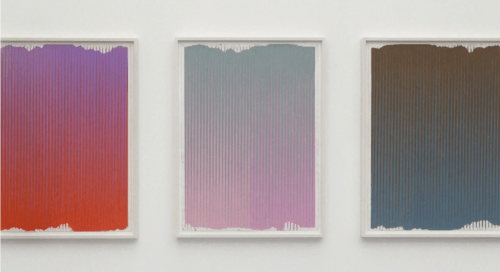
Gavlak is proud to present Lonely Planet, a major exhibition of new work by Andrew Brischler that will take place simultaneously at both the Los Angeles and Palm Beach galleries. This is the artist’s fourth solo presentation with the gallery.
Andrew Brischler creates bold, energetic works on paper and panel using almost exclusively colored pencil. Richly colored and laboriously hand drawn, Brischler’s work investigates the intersection of graphic design and abstraction through his devotion to drawing. He painstakingly draws colorful, geometric patterns and fragments of typography, leaving areas unfinished and purposely battered. Brischler’s source material is culled from a wide swath of cultural references including book covers, vintage film posters, ephemera from long-out-of-print queer publications, and digital imagery in the age of social media.
Lonely Planet takes its title from the 1993 play by Steven Dietz. Set in the 1980s at the height of the AIDS crisis, the play revolves around two gay men in an unnamed American city who ponder death and friendship in the wake of the new epidemic. Using the production’s broad themes of evanescence, entropy, loss, and compassion as a jumping off point, Brischler has created two distinct bodies of work that have been instrumental for him to make sense of this particular sociopolitical moment.
For the Los Angeles gallery, Brischler will show a series of 41 gradient drawings that—when seen as a complete installation—create a frenetic color spectrum. As with all of Brischler’s work, this entirely abstract installation comes from a deeply personal place. During an HIV scare in 2016, Brischler waited for his (ultimately negative) test results in his doctor’s office in Brooklyn, New York. In the waiting room, Brischler looked up and saw a strange, optically dazzling pattern of black and white created by sunlight filtering through the vertical blinds. He snapped a photo, and upon returning to his studio, made a dozen small studies using this strange knife-edge pattern as a jumping off point. Over the course of the following year, Brischler let the series grow to this uniquely large scale. For Brischler, this series is a way to confront anxiety, banish shame, and connect with a lineage of gay men who came before him.
In contrast to the Los Angeles gallery, Brischler has chosen to focus entirely on typography for Palm Beach. Words and phrases like “Constant Cravings,” “Bottomless Pit,” and “Promises, Promises” are distorted, stylized and sit in a precarious place between abstraction and commercial design. Each piece simultaneously confronts and aestheticizes the artist’s personal day-to-day challenges and the universal human emotions that Dietz explores in his stage play. Brischler sees his entire practice—but especially the work using text—as a continuous record of his own neuroses. Each work is a piece of cultural detritus, part of an ever-evolving narrative of his personal pop cultural canon.
To further deepen the project, Brischler has chosen to utilize the second gallery at Gavlak Palm Beach as a curatorial space. In Brischler’s words, “the studio has always been my first line of defense against my anxieties, neuroses, and fears.” To that end, Brischler has organized an idiosyncratic, densely hung salon wall of work from artists—both emerging and established—who use their studios as labs of transgression during times of personal or political upheaval. Artists featured include Judie Bamber, Lecia Dole-Recio, Judith Eisler, Keltie Ferris, Tim Gardner, Ross Hansen, Mary Heilmann, Karen Kilimnik, Ryan McGinley, Marilyn Minter, Paul P., Betty Parsons, Joyce Pensato, Jack Pierson, Nathaniel Mary Quinn, Bryson Rand, Ugo Rondinone, Dean Sameshima, Peter Shear, Matthew Tiernan, Tom of Finland, and Rob Wynne.